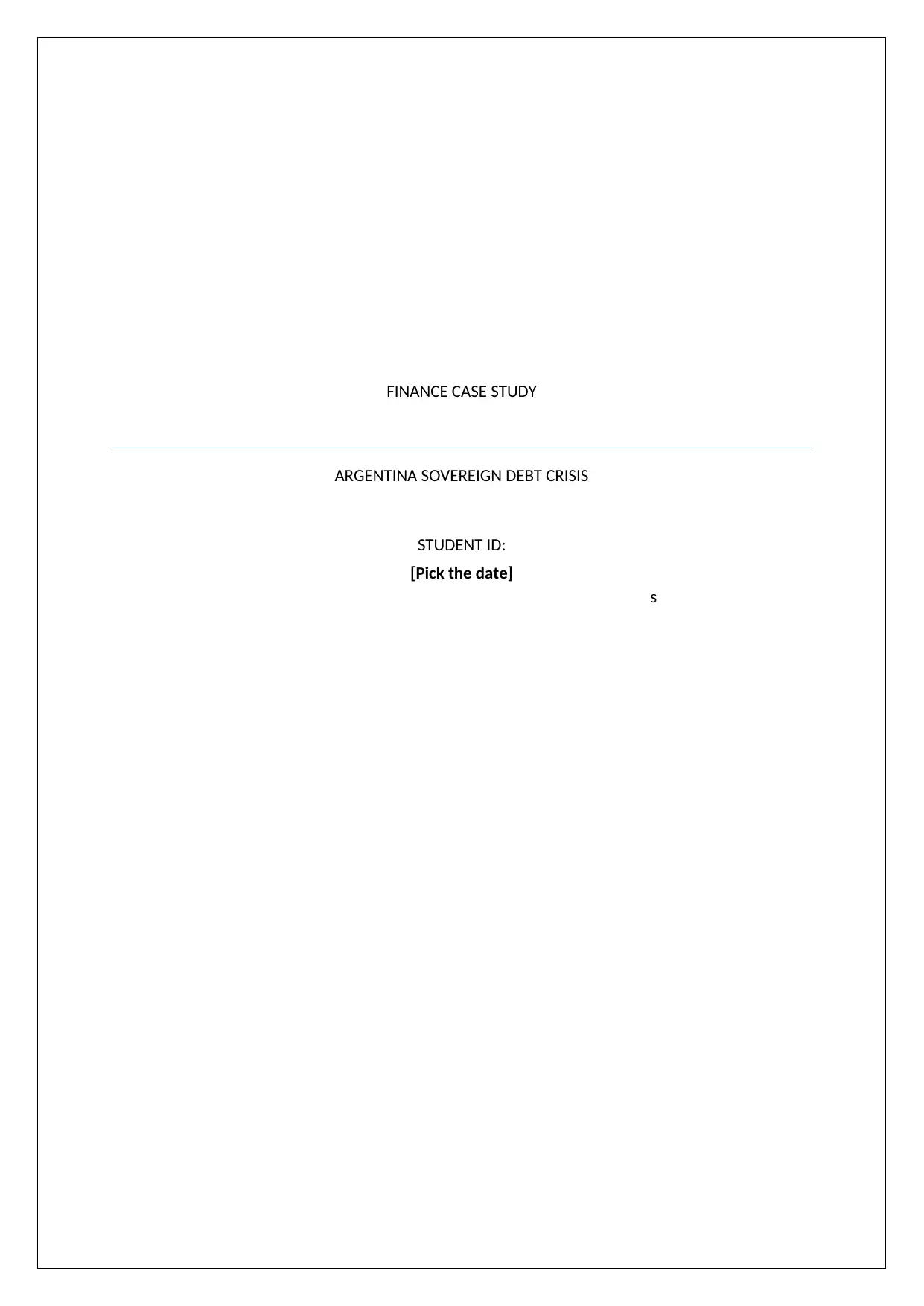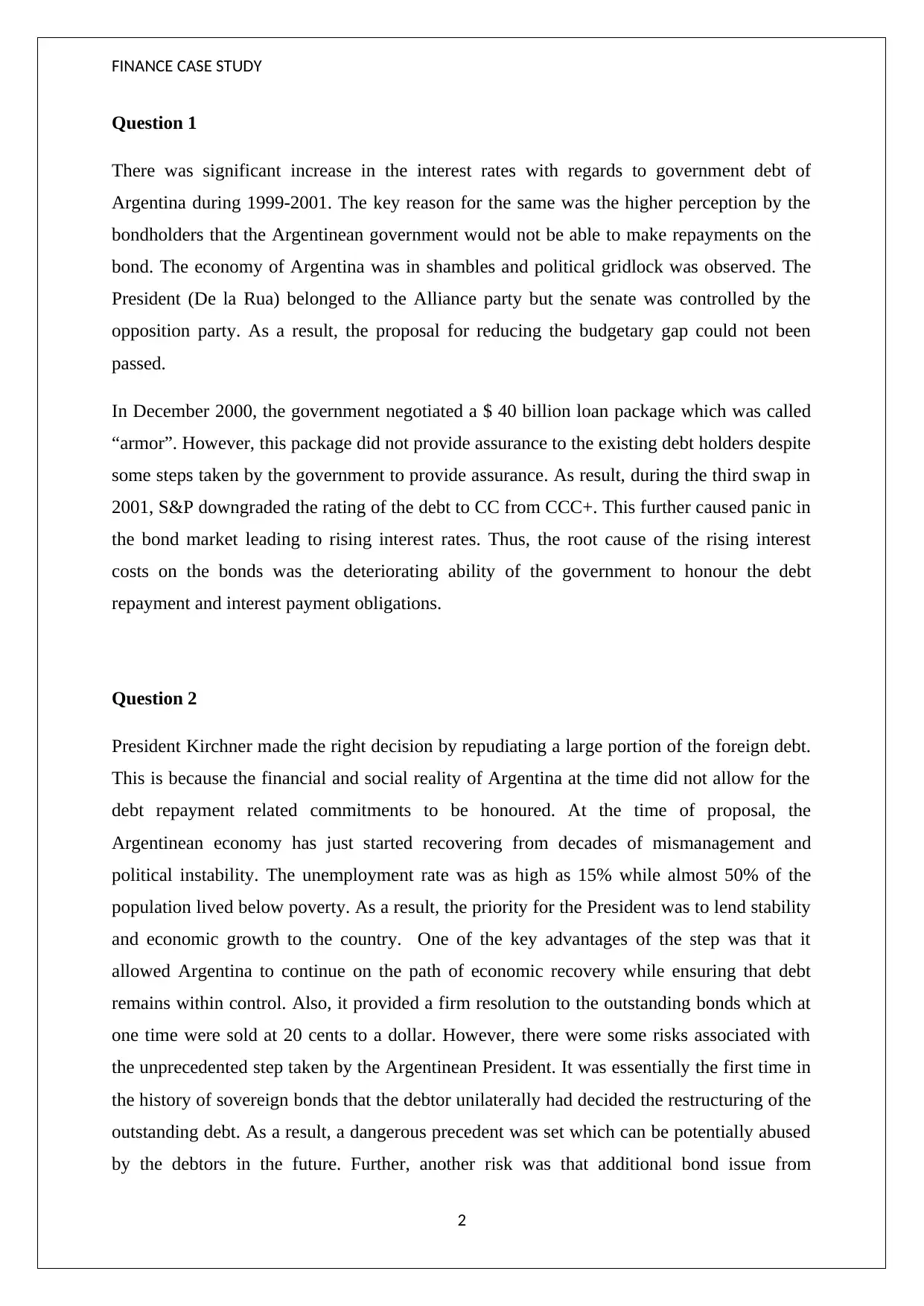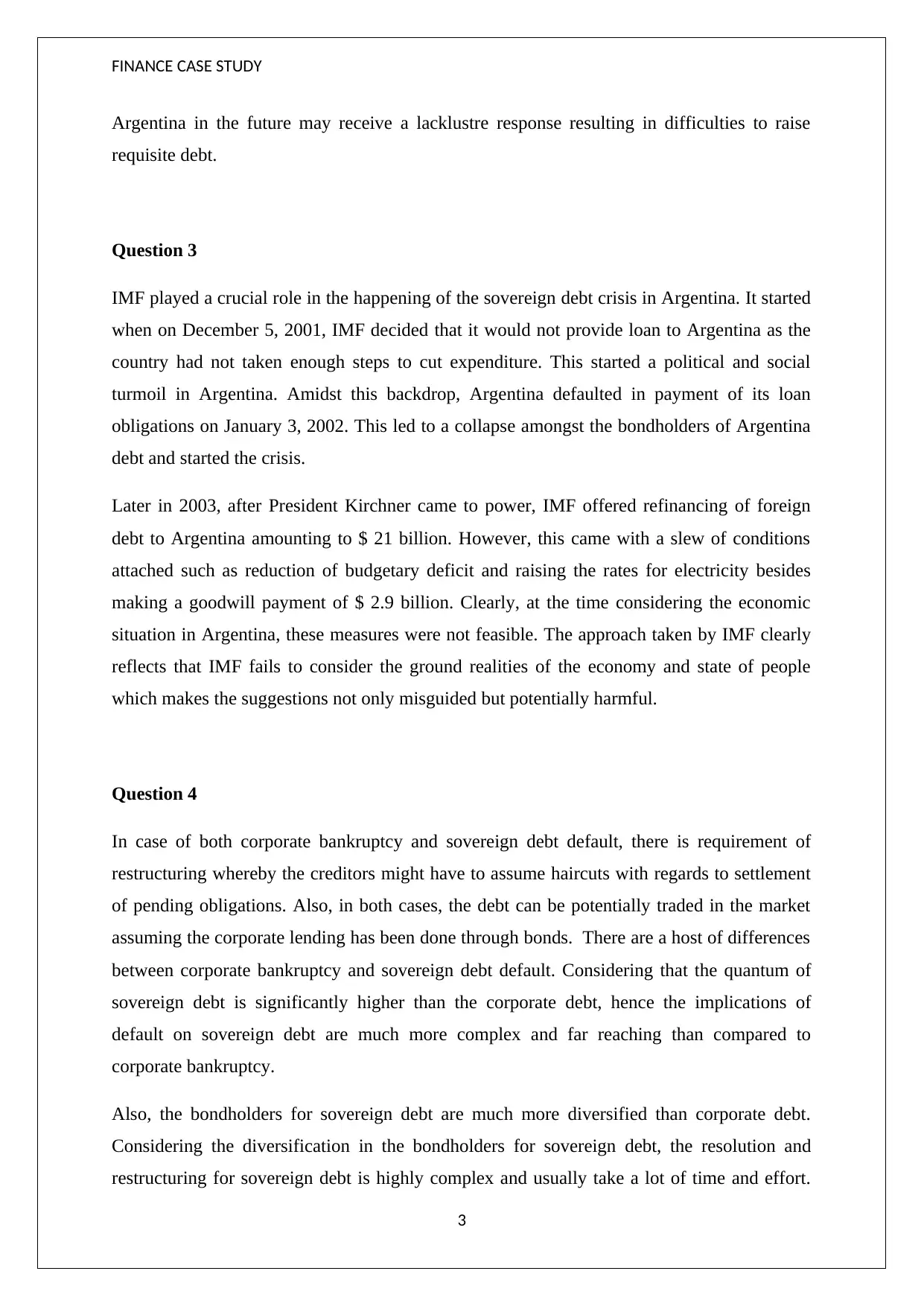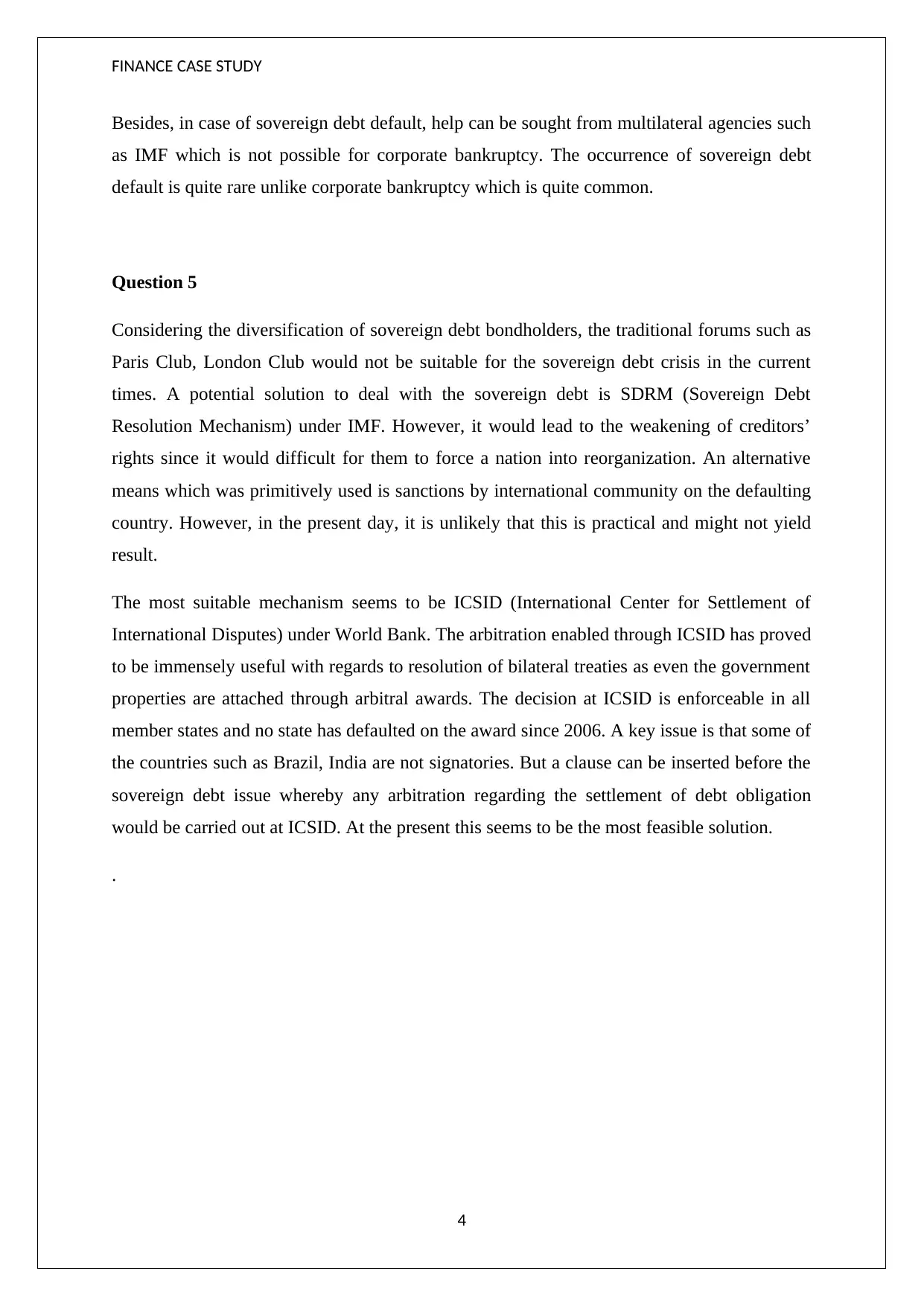Argentina Sovereign Debt Crisis: Finance Case Study Analysis, [Date]
VerifiedAdded on 2023/01/16
|4
|1131
|28
Case Study
AI Summary
This finance case study analyzes the Argentina sovereign debt crisis from 1999-2001, focusing on the rising interest rates on government debt due to bondholder concerns about repayment. It examines President Kirchner's decision to repudiate a portion of the foreign debt, the role of the IMF, and the differences between corporate bankruptcy and sovereign debt default. The case study explores the impact of IMF's actions, the advantages and risks of debt restructuring, and potential solutions like the SDRM and ICSID mechanisms for resolving sovereign debt issues. The analysis provides a comprehensive overview of the crisis's causes, consequences, and possible approaches to manage such situations.

FINANCE CASE STUDY
ARGENTINA SOVEREIGN DEBT CRISIS
STUDENT ID:
[Pick the date]
s
ARGENTINA SOVEREIGN DEBT CRISIS
STUDENT ID:
[Pick the date]
s
Paraphrase This Document
Need a fresh take? Get an instant paraphrase of this document with our AI Paraphraser

FINANCE CASE STUDY
Question 1
There was significant increase in the interest rates with regards to government debt of
Argentina during 1999-2001. The key reason for the same was the higher perception by the
bondholders that the Argentinean government would not be able to make repayments on the
bond. The economy of Argentina was in shambles and political gridlock was observed. The
President (De la Rua) belonged to the Alliance party but the senate was controlled by the
opposition party. As a result, the proposal for reducing the budgetary gap could not been
passed.
In December 2000, the government negotiated a $ 40 billion loan package which was called
“armor”. However, this package did not provide assurance to the existing debt holders despite
some steps taken by the government to provide assurance. As result, during the third swap in
2001, S&P downgraded the rating of the debt to CC from CCC+. This further caused panic in
the bond market leading to rising interest rates. Thus, the root cause of the rising interest
costs on the bonds was the deteriorating ability of the government to honour the debt
repayment and interest payment obligations.
Question 2
President Kirchner made the right decision by repudiating a large portion of the foreign debt.
This is because the financial and social reality of Argentina at the time did not allow for the
debt repayment related commitments to be honoured. At the time of proposal, the
Argentinean economy has just started recovering from decades of mismanagement and
political instability. The unemployment rate was as high as 15% while almost 50% of the
population lived below poverty. As a result, the priority for the President was to lend stability
and economic growth to the country. One of the key advantages of the step was that it
allowed Argentina to continue on the path of economic recovery while ensuring that debt
remains within control. Also, it provided a firm resolution to the outstanding bonds which at
one time were sold at 20 cents to a dollar. However, there were some risks associated with
the unprecedented step taken by the Argentinean President. It was essentially the first time in
the history of sovereign bonds that the debtor unilaterally had decided the restructuring of the
outstanding debt. As a result, a dangerous precedent was set which can be potentially abused
by the debtors in the future. Further, another risk was that additional bond issue from
2
Question 1
There was significant increase in the interest rates with regards to government debt of
Argentina during 1999-2001. The key reason for the same was the higher perception by the
bondholders that the Argentinean government would not be able to make repayments on the
bond. The economy of Argentina was in shambles and political gridlock was observed. The
President (De la Rua) belonged to the Alliance party but the senate was controlled by the
opposition party. As a result, the proposal for reducing the budgetary gap could not been
passed.
In December 2000, the government negotiated a $ 40 billion loan package which was called
“armor”. However, this package did not provide assurance to the existing debt holders despite
some steps taken by the government to provide assurance. As result, during the third swap in
2001, S&P downgraded the rating of the debt to CC from CCC+. This further caused panic in
the bond market leading to rising interest rates. Thus, the root cause of the rising interest
costs on the bonds was the deteriorating ability of the government to honour the debt
repayment and interest payment obligations.
Question 2
President Kirchner made the right decision by repudiating a large portion of the foreign debt.
This is because the financial and social reality of Argentina at the time did not allow for the
debt repayment related commitments to be honoured. At the time of proposal, the
Argentinean economy has just started recovering from decades of mismanagement and
political instability. The unemployment rate was as high as 15% while almost 50% of the
population lived below poverty. As a result, the priority for the President was to lend stability
and economic growth to the country. One of the key advantages of the step was that it
allowed Argentina to continue on the path of economic recovery while ensuring that debt
remains within control. Also, it provided a firm resolution to the outstanding bonds which at
one time were sold at 20 cents to a dollar. However, there were some risks associated with
the unprecedented step taken by the Argentinean President. It was essentially the first time in
the history of sovereign bonds that the debtor unilaterally had decided the restructuring of the
outstanding debt. As a result, a dangerous precedent was set which can be potentially abused
by the debtors in the future. Further, another risk was that additional bond issue from
2

FINANCE CASE STUDY
Argentina in the future may receive a lacklustre response resulting in difficulties to raise
requisite debt.
Question 3
IMF played a crucial role in the happening of the sovereign debt crisis in Argentina. It started
when on December 5, 2001, IMF decided that it would not provide loan to Argentina as the
country had not taken enough steps to cut expenditure. This started a political and social
turmoil in Argentina. Amidst this backdrop, Argentina defaulted in payment of its loan
obligations on January 3, 2002. This led to a collapse amongst the bondholders of Argentina
debt and started the crisis.
Later in 2003, after President Kirchner came to power, IMF offered refinancing of foreign
debt to Argentina amounting to $ 21 billion. However, this came with a slew of conditions
attached such as reduction of budgetary deficit and raising the rates for electricity besides
making a goodwill payment of $ 2.9 billion. Clearly, at the time considering the economic
situation in Argentina, these measures were not feasible. The approach taken by IMF clearly
reflects that IMF fails to consider the ground realities of the economy and state of people
which makes the suggestions not only misguided but potentially harmful.
Question 4
In case of both corporate bankruptcy and sovereign debt default, there is requirement of
restructuring whereby the creditors might have to assume haircuts with regards to settlement
of pending obligations. Also, in both cases, the debt can be potentially traded in the market
assuming the corporate lending has been done through bonds. There are a host of differences
between corporate bankruptcy and sovereign debt default. Considering that the quantum of
sovereign debt is significantly higher than the corporate debt, hence the implications of
default on sovereign debt are much more complex and far reaching than compared to
corporate bankruptcy.
Also, the bondholders for sovereign debt are much more diversified than corporate debt.
Considering the diversification in the bondholders for sovereign debt, the resolution and
restructuring for sovereign debt is highly complex and usually take a lot of time and effort.
3
Argentina in the future may receive a lacklustre response resulting in difficulties to raise
requisite debt.
Question 3
IMF played a crucial role in the happening of the sovereign debt crisis in Argentina. It started
when on December 5, 2001, IMF decided that it would not provide loan to Argentina as the
country had not taken enough steps to cut expenditure. This started a political and social
turmoil in Argentina. Amidst this backdrop, Argentina defaulted in payment of its loan
obligations on January 3, 2002. This led to a collapse amongst the bondholders of Argentina
debt and started the crisis.
Later in 2003, after President Kirchner came to power, IMF offered refinancing of foreign
debt to Argentina amounting to $ 21 billion. However, this came with a slew of conditions
attached such as reduction of budgetary deficit and raising the rates for electricity besides
making a goodwill payment of $ 2.9 billion. Clearly, at the time considering the economic
situation in Argentina, these measures were not feasible. The approach taken by IMF clearly
reflects that IMF fails to consider the ground realities of the economy and state of people
which makes the suggestions not only misguided but potentially harmful.
Question 4
In case of both corporate bankruptcy and sovereign debt default, there is requirement of
restructuring whereby the creditors might have to assume haircuts with regards to settlement
of pending obligations. Also, in both cases, the debt can be potentially traded in the market
assuming the corporate lending has been done through bonds. There are a host of differences
between corporate bankruptcy and sovereign debt default. Considering that the quantum of
sovereign debt is significantly higher than the corporate debt, hence the implications of
default on sovereign debt are much more complex and far reaching than compared to
corporate bankruptcy.
Also, the bondholders for sovereign debt are much more diversified than corporate debt.
Considering the diversification in the bondholders for sovereign debt, the resolution and
restructuring for sovereign debt is highly complex and usually take a lot of time and effort.
3
⊘ This is a preview!⊘
Do you want full access?
Subscribe today to unlock all pages.

Trusted by 1+ million students worldwide

FINANCE CASE STUDY
Besides, in case of sovereign debt default, help can be sought from multilateral agencies such
as IMF which is not possible for corporate bankruptcy. The occurrence of sovereign debt
default is quite rare unlike corporate bankruptcy which is quite common.
Question 5
Considering the diversification of sovereign debt bondholders, the traditional forums such as
Paris Club, London Club would not be suitable for the sovereign debt crisis in the current
times. A potential solution to deal with the sovereign debt is SDRM (Sovereign Debt
Resolution Mechanism) under IMF. However, it would lead to the weakening of creditors’
rights since it would difficult for them to force a nation into reorganization. An alternative
means which was primitively used is sanctions by international community on the defaulting
country. However, in the present day, it is unlikely that this is practical and might not yield
result.
The most suitable mechanism seems to be ICSID (International Center for Settlement of
International Disputes) under World Bank. The arbitration enabled through ICSID has proved
to be immensely useful with regards to resolution of bilateral treaties as even the government
properties are attached through arbitral awards. The decision at ICSID is enforceable in all
member states and no state has defaulted on the award since 2006. A key issue is that some of
the countries such as Brazil, India are not signatories. But a clause can be inserted before the
sovereign debt issue whereby any arbitration regarding the settlement of debt obligation
would be carried out at ICSID. At the present this seems to be the most feasible solution.
.
4
Besides, in case of sovereign debt default, help can be sought from multilateral agencies such
as IMF which is not possible for corporate bankruptcy. The occurrence of sovereign debt
default is quite rare unlike corporate bankruptcy which is quite common.
Question 5
Considering the diversification of sovereign debt bondholders, the traditional forums such as
Paris Club, London Club would not be suitable for the sovereign debt crisis in the current
times. A potential solution to deal with the sovereign debt is SDRM (Sovereign Debt
Resolution Mechanism) under IMF. However, it would lead to the weakening of creditors’
rights since it would difficult for them to force a nation into reorganization. An alternative
means which was primitively used is sanctions by international community on the defaulting
country. However, in the present day, it is unlikely that this is practical and might not yield
result.
The most suitable mechanism seems to be ICSID (International Center for Settlement of
International Disputes) under World Bank. The arbitration enabled through ICSID has proved
to be immensely useful with regards to resolution of bilateral treaties as even the government
properties are attached through arbitral awards. The decision at ICSID is enforceable in all
member states and no state has defaulted on the award since 2006. A key issue is that some of
the countries such as Brazil, India are not signatories. But a clause can be inserted before the
sovereign debt issue whereby any arbitration regarding the settlement of debt obligation
would be carried out at ICSID. At the present this seems to be the most feasible solution.
.
4
1 out of 4
Your All-in-One AI-Powered Toolkit for Academic Success.
+13062052269
info@desklib.com
Available 24*7 on WhatsApp / Email
![[object Object]](/_next/static/media/star-bottom.7253800d.svg)
Unlock your academic potential
Copyright © 2020–2025 A2Z Services. All Rights Reserved. Developed and managed by ZUCOL.